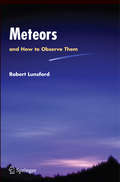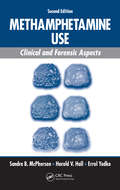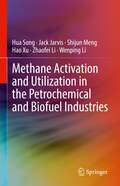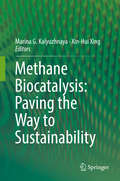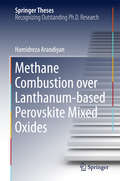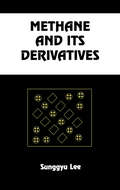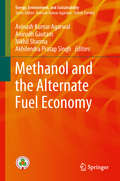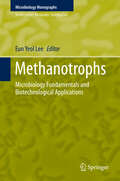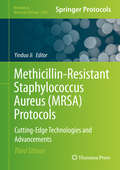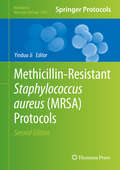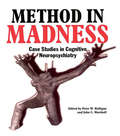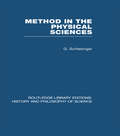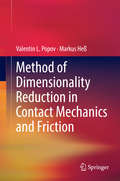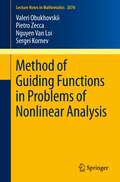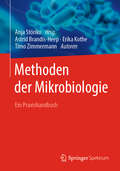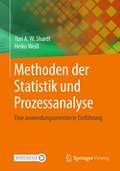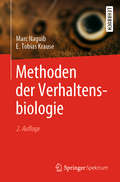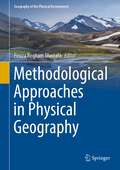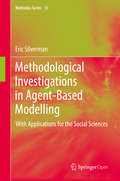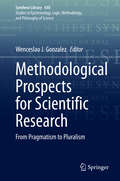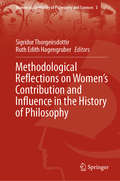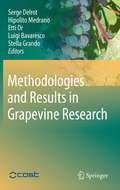- Table View
- List View
Meteors and How to Observe Them
by Robert LunsfordThe focus of this book is to introduce the novice to the art of meteor observing. It explains in straightforward language how best to view meteor activity under a variety of conditions, regardless of the observer's location. The observing conditions for each meteor shower are vastly different from each of the Earth's regions and this book would be valuable to any potential observer from Australia to Alaska. The calendar chapters list activity as it occurs throughout the year. The list is limited to showers that the amateur observer can actually see (some sources list radiants that are impossible to observe without photographic or video methods). Not only are the annual showers discussed, but the random sporadic meteor activity is also included for each region. This is important, as there are many more nights throughout the year when the sporadic background will provide more activity than that provided by the annual showers!
Methamphetamine Use: Clinical and Forensic Aspects, Second Edition
by Sandra B. McPherson Harold V. Hall Errol YudkoUpdated and expanded to reflect changes in recent years, this second edition covers virtually every aspect of this dangerous drug, including history, pharmacology, pathology, physiology, treatment, clinical and forensic psychology, and legal aspects. This edition features new chapters on criminal- and civil-forensic applications including an in-depth discussion of recent laws. Pointing out important cases, articles, and statistics, the text also presents chapters on neuropsychological testing; normative data on risk analysis and violence prediction; the physiology of tweaking, the most dangerous stage of the meth cycle; and the efficacy of treatment programs including examples from newly established drug courts.
Methane Activation and Utilization in the Petrochemical and Biofuel Industries
by Hao Xu Hua Song Jack Jarvis Shijun Meng Zhaofei Li Wenping LiThis book discusses effective and alternative uses for natural gas (NG) and highlights the utilization of NG in the field of methane activation and chemical production. It details the techniques used during the reforming process of petrochemical and bio-derived fuels and it presents cutting-edge research that describes the utilization of NG that enables it to be more cost-effective and eliminate the expensive greenhouse gas emitting process of hydrogen production. The book addresses three major topics: NG use in upstream heavy oil and bitumen upgrading, NG and its use in downstream oil refining through co-aromatization of various feeds in the petrochemical industry, and NG use in the upgrading of bio-derived fuels and discusses alternative uses of NG. In-depth chapters demonstrate uses for NG beyond heating homes, through catalysis and in-situ hydrogen donation, and its potential applications for the petrochemical and biofuel industries.
Methane Biocatalysis: Paving the Way to Sustainability
by Marina G. Kalyuzhnaya Xin-Hui XingThis book provides in-depth insights into the most recent developments in different areas of microbial methane and methanol utilization, including novel fundamental discoveries in genomics and physiology, innovative strategies for metabolic engineering and new synthetic approaches for generation of feedstocks, chemicals and fuels from methane, and finally economics and the implementation of industrial biocatalysis using methane consuming bacteria. Methane, as natural gas or biogas, penetrates every area of human activity, from households to large industries and is often promoted as the cleanest fuel. However, one should not forget that this bundle of energy, carbon, and hydrogen comes with an exceptionally large environmental footprint. To meet goals of long-term sustainability and human well-being, all areas of energy, chemicals, agriculture, waste-management industries must go beyond short-term economic considerations and target both large and small methane emissions. The search for new environment-friendly approaches for methane capture and valorization is an ongoing journey. While it is not yet apparent which innovation might represent the best solution, it is evident that methane biocatalysis is one of the most promising paths. Microbes are gatekeepers of fugitive methane in Nature. Methane-consuming microbes are typically small in number but exceptionally big in their impact on the natural carbon cycle. They control and often completely eliminate methane emission from a variety of biological and geothermal sources. The tremendous potential of these microbial systems, is only now being implemented in human-made systems. The book addresses professors, researchers and graduate students from both academia and industry working in microbial biotechnology, molecular biology and chemical engineering.
Methane Combustion over Lanthanum-based Perovskite Mixed Oxides
by Hamidreza ArandiyanThis book presents current research into the catalytic combustion of methane using perovskite-type oxides (ABO3). Catalytic combustion has been developed as a method of promoting efficient combustion with minimum pollutant formation as compared to conventional catalytic combustion. Recent theoretical and experimental studies have recommended that noble metals supported on (ABO3) with well-ordered porous networks show promising redox properties. Three-dimensionally ordered macroporous (3DOM) materials with interpenetrated and regular mesoporous systems have recently triggered enormous research activity due to their high surface areas, large pore volumes, uniform pore sizes, low cost, environmental benignity, and good chemical stability. These are all highly relevant in terms of the utilization of natural gas in light of recent catalytic innovations and technological advances. The book is of interest to all researchers active in utilization of natural gas with novel catalysts. The research covered comes from the most important industries and research centers in the field. The book serves not only as a text for researcher into catalytic combustion of methane, 3DOM perovskite mixed oxide, but also explores the field of green technologies by experts in academia and industry. This book will appeal to those interested in research on the environmental impact of combustion, materials and catalysis.
Methane and its Derivatives (Chemical Industries Ser. #70)
by Sunggyu Lee"Covers the chemistry, process chemistry, technology, engineering, and economics of methane conversion, including its environmental impact and commercial exploitation. Begins with methane's availability and increasing importance as an environmentally acceptable natural resource alternative and feedstock."
Methanol and the Alternate Fuel Economy (Energy, Environment, and Sustainability)
by Avinash Kumar Agarwal Akhilendra Pratap Singh Anirudh Gautam Nikhil SharmaThis book discusses the emerging research centred on using methanol- whose excellent fuel properties, easy production and relative compatibility with existing technology- make it attractive to researchers looking to alternative fuels to meet the rising energy demand. The volume is divided into broadly 4 parts which discuss various aspects of the proposed methanol economy and the technological advances in engine design for the utilisation of this fuel. This book will be of interest to researchers and policy makers interested in using methanol as the principal source of ready and stored energy in societal functioning.
Methanol: The Basic Chemical and Energy Feedstock of the Future
by Martin Bertau Heribert Offermanns Ludolf Plass Friedrich Schmidt Hans-Jürgen WernickeMethanol - The Chemical and Energy Feedstock of the Future offers a visionary yet unbiased view of methanol technology. Based on the groundbreaking 1986 publication "Methanol" by Friedrich Asinger, this book includes contributions by more than 40 experts from industry and academia. The authors and editors provide a comprehensive exposition of methanol chemistry and technology which is useful for a wide variety of scientists working in chemistry and energy related industries as well as academic researchers and even decision-makers and organisations concerned with the future of chemical and energy feedstocks.
Methanotrophs: Microbiology Fundamentals and Biotechnological Applications (Microbiology Monographs #32)
by Eun Yeol LeeThis book offers a comprehensive overview of the microbiological fundamentals and biotechnological applications of methanotrophs: aerobic proteobacteria that can utilize methane as their sole carbon and energy source. It highlights methanotrophs’ pivotal role in the global carbon cycle, in which they remove methane generated geothermally and by methanogens. Readers will learn how methanotrophs have been employed as biocatalysts for mitigating methane gas and remediating halogenated hydrocarbons in soil and underground water. Recently, methane has also attracted considerable attention as a potential next-generation carbon feedstock for industrial biotechnology, because of its abundance and low price. Methanotrophs can be used as biocatalysts for the production of fuels, chemicals and biomaterials including methanobactin from methane under environmentally benign production conditions. Sharing these and other cutting-edge insights, the book offers a fascinating read for all scientists and students of microbiology and biotechnology.
Methicillin-Resistant Staphylococcus Aureus: Cutting-Edge Technologies and Advancements (Methods in Molecular Biology #2069)
by Yinduo JiThis third edition volume expands on the previous editions with an update on the latest techniques used for the detection, genotyping, and investigating pathogenesis of Staphylococcus aureus in vitro and in vivo. The methods covered in this book mostly focus on routine clinical diagnosis, surveillance, research, and practice for treatment of patients infected by multi-drug resistant S. aureus. The book also covers the epidemiology of MRSA, molecular typing approaches, clinical treatment of MRSA infections, and animal models of drug discovery. Written in the highly successful Methods in Molecular Biology series format, chapters include introductions to their respective topics, lists of the necessary materials and reagents, step-by-step, readily reproducible laboratory protocols, and tips on troubleshooting and avoiding known pitfalls.Informative and cutting-edge, Methicillin-Resistant Staphylococcus Aureus (MRSA) Protocols: Cutting-Edge Technologies and Advancements, Third Edition is a valuable resource for researchers looking to set up new methods to study S. aureus, and will also be very useful for technicians and scientists working on other bacterial pathogens.
Methicillin-Resistant Staphylococcus aureus (MRSA) Protocols
by Yinduo JiThis book provides a comprehensive collection of the most up-to-date techniques for the detection and investigation of MRSA. Each chapter begins with a brief introduction to the method and purpose, and then goes into detailed protocols for every step of analysis. Several chapters also include a section with tips not usually found in methods books. These tips may represent the difference between immediate success and lengthy troubleshooting.
Method In Madness: Case Studies In Cognitive Neuropsychiatry
by John C. Marshall Peter W. HalliganIn clinical neuropsychiatry, case studies provide invaluable demonstrations of the range and types of unusual psychological states that can occur after brain damage. In the pursuit of objectivity and scientific respectability, however, many academic reports of neuropsychiatric disorders appear cold, contrived and impersonal. The essence and character of the patient's experience and behaviour is easily obscured or even lost - a fact that cannot help researchers, therapists and other practitioners to relate their conceptual knowledge to the flesh-and-blood people they meet in their professional lives. In practice, much of the actual discourse of such patients has been ignored as unworthy of scientific interest. This book describes real patients in a clear and jargon-free way. These cases should serve to reduce the discrepancy between the formal representations of psychiatric illness in the mainstream literature and the reality of people struggling to make sense of their own predicament in everyday life.
Method in the Physical Sciences (Routledge Library Editions: History & Philosophy of Science)
by G SchlesingerOriginally published in 1963. Can one discern certain regularities in the manoeuvrings and techniques employed by scientists and can these be formulated into the methodological principles of science? What is the origin and basis of such principles? Are they imposed by objective realities, do they derive from conceptual necessities or are they rooted in our own deep seated predilections? This volume investigates these questions and sheds light on the growth mechanism of the evolving structure of science itself.
Method of Dimensionality Reduction in Contact Mechanics and Friction
by Valentin L. Popov Markus HeßThis book describes for the first time a simulation method for the fast calculation of contact properties and friction between rough surfaces in a complete form. In contrast to existing simulation methods, the method of dimensionality reduction (MDR) is based on the exact mapping of various types of three-dimensional contact problems onto contacts of one-dimensional foundations. Within the confines of MDR, not only are three dimensional systems reduced to one-dimensional, but also the resulting degrees of freedom are independent from another. Therefore, MDR results in an enormous reduction of the development time for the numerical implementation of contact problems as well as the direct computation time and can ultimately assume a similar role in tribology as FEM has in structure mechanics or CFD methods, in hydrodynamics. Furthermore, it substantially simplifies analytical calculation and presents a sort of "pocket book edition" of the entirety contact mechanics. Measurements of the rheology of bodies in contact as well as their surface topography and adhesive properties are the inputs of the calculations. In particular, it is possible to capture the entire dynamics of a system - beginning with the macroscopic, dynamic contact calculation all the way down to the influence of roughness - in a single numerical simulation model. Accordingly, MDR allows for the unification of the methods of solving contact problems on different scales. The goals of this book are on the one hand, to prove the applicability and reliability of the method and on the other hand, to explain its extremely simple application to those interested.
Method of Dimensionality Reduction in Contact Mechanics and Friction
by Valentin L. Popov Markus HeßThis book describes for the first time a simulation method for the fast calculation of contact properties and friction between rough surfaces in a complete form. In contrast to existing simulation methods, the method of dimensionality reduction (MDR) is based on the exact mapping of various types of three-dimensional contact problems onto contacts of one-dimensional foundations. Within the confines of MDR, not only are three dimensional systems reduced to one-dimensional, but also the resulting degrees of freedom are independent from another. Therefore, MDR results in an enormous reduction of the development time for the numerical implementation of contact problems as well as the direct computation time and can ultimately assume a similar role in tribology as FEM has in structure mechanics or CFD methods, in hydrodynamics. Furthermore, it substantially simplifies analytical calculation and presents a sort of “pocket book edition” of the entirety contact mechanics. Measurements of the rheology of bodies in contact as well as their surface topography and adhesive properties are the inputs of the calculations. In particular, it is possible to capture the entire dynamics of a system – beginning with the macroscopic, dynamic contact calculation all the way down to the influence of roughness – in a single numerical simulation model. Accordingly, MDR allows for the unification of the methods of solving contact problems on different scales. The goals of this book are on the one hand, to prove the applicability and reliability of the method and on the other hand, to explain its extremely simple application to those interested.
Method of Guiding Functions in Problems of Nonlinear Analysis
by Valeri Obukhovskii Sergei Kornev Nguyen Van Loi Pietro ZeccaThis book offers a self-contained introduction to the theory of guiding functions methods, which can be used to study the existence of periodic solutions and their bifurcations in ordinary differential equations, differential inclusions and in control theory. It starts with the basic concepts of nonlinear and multivalued analysis, describes the classical aspects of the method of guiding functions, and then presents recent findings only available in the research literature. It describes essential applications in control theory, the theory of bifurcations, and physics, making it a valuable resource not only for "pure" mathematicians, but also for students and researchers working in applied mathematics, the engineering sciences and physics.
Methoden der Mikrobiologie: Ein Praxishandbuch
by Erika Kothe Timo Zimmermann Astrid Brandis-HeepDieses Lehrbuch bietet Antworten auf Fragen wie „Wie funktioniert diese mikrobiologische Methode ganz praktisch? Wie kann ich meine Forschung um eine sinnvolle Methode erweitern?“ Vergleichbar einem Kochbuch sind Zutaten und einzelne Handgriffe übersichtlich aufgelistet und mit praktischen Tipps und Gefahrenhinweisen versehen. Ob zu Fluoreszenzmikroskopie, Genomik oder Isolierung und Kultivierung von Bakterien, Archaeen und Pilzen - erfahrene MikrobiologInnen finden hier ebenso schnelle Hinweise wie Quereinsteiger, die ihr Arbeitsgebiet mikrobiologisch erweitern wollen. Die fachkundigen PraktikerInnen Astrid Brandis-Heep, Erika Kothe und Timo Zimmermann haben übersichtlich praktische Methoden und Ratschläge für den Laboralltag zusammengestellt, die - mikrobiologisches Grundwissen vorausgesetzt - Masterstudierenden, Doktoranden, Postdocs und fortgeschrittenen Arbeitsgruppen sowohl im Alltag als auch für eine Neuausrichtung Ihrer Forschung entscheidende Hinweise geben.
Methoden der Statistik und Prozessanalyse: Eine anwendungsorientierte Einführung
by Yuri Shardt Heiko WeißDieses Buch konzentriert sich auf die Anwendung von modernen Methoden derStatistik zur Modellierung und Analyse von Prozessmodellen der Verfahrenstechnik.Beispiele für moderne Methoden sind Matrixansätze, im Gegensatz zumanuellen Berechnungen, sowie das Konzept orthogonaler Basen. Diese Ansätzeermöglichen eine computergestützte Analyse von Versuchsplänen.Zunächst werden die wichtigsten Aspekte und Methoden der Statistik und Prozessanalysevorgestellt. Auf dieserGrundlage werden anschließend komplexere Methoden für die Anwendungerarbeitet. Hierbei legen die Autoren großen Wert auf eine kurze, jedoch umfassendeund konsistente Darstellung.Zur Erleichterung der Implementierung werden detaillierte Vorgehensweisen fürdie relevanten Konzepte vorgestellt und anhand geeigneter Beispiele vorgestellt. Die Beispiele sind so gewählt, dass sie mit vorhandenen Softwarewerkzeugen (Matlab, Excel) nachgebildet werden können. Für diesen Zweck werden Excel-Vorlagen undMATLAB-Programme bereitgestellt. Ein ausführliches deutsch-englisches Glossar ist ebenfalls enthalten.
Methoden der Verhaltensbiologie (Springer-lehrbuch Ser.)
by Marc Naguib E. Tobias KrauseMarc Naguib erklärt die grundlegenden Methoden der qualitativen und quantitativen Erfassung von Verhalten. Dabei werden deskriptive und experimentelle Ansätze von Versuchsplänen berücksichtigt. Anhand von Beispielen aus der aktuellen Forschung wird die Breite der modernen verhaltensbiologischen Forschung anschaulich dargestellt.
Methodological Approaches in Physical Geography (Geography of the Physical Environment)
by Firuza Begham MustafaGeography science aims to observe the dynamics in describing earth's surface as a place and space for humans to carry out their lives, starting from simple identification using recording and sketching models, then utilizing tools such as maps, satellite imagery, statistics and Geographic Information Systems (GIS). In the development of geography science, it is appropriate to explain phenomena of the earth in the present context along with the process of developing science and technology using suitable and effective methods. Physical geography is the branch of natural science that deals with the study of processes and patterns in the natural environment such as the atmosphere, hydrosphere, lithosphere and biosphere. This book covers the methodology of the study for all aspects of physical geography, biosphere, hydrosphere, lithosphere, and atmosphere. A comprehensive geography textbook consists of a detailed research methodology for physical geography research including a few selected case studies in Asia. The uniqueness of this book is due to the contribution of several professors and subject experts from South East and East Asia with special particular reference to cases studies from a particular region. This book covered selected methodological approaches for hydrology, climatology and geomorphology including the discovery of the best method for exploring and assessing mysterious physical phenomena using a diversity of methodologies. This book explains the principal concept, basic method, optional method, detailed description of each method, and the advantages and disadvantages of the various methods. The technique of data selection, data acquisition, method of analysis, data interpretation and data analysis techniques with a specific focus on deterministic modeling, geography techniques, geospatial modeling with Geographic Information System (GIS), Artificial Intelligence (AI), Analytic Hierarchy Process (AHP), and Automated machine techniques and combination of statistical analysis. This book attempts to explore different approaches, methodological possibilities and challenges in conducting geographical research in physical geography. New digital geographic data sources and GIS applications can help researchers to receive clearer concepts and obtain better measurements of the relevant attributes changes in the physical environment. Opportunity to critically examine the conceptualization and identification of the field in geographical research and how digital media has not only expanded the scope of what constitutes the field but has redefined the field in itself as well as the practices of observing, knowing, and analyzing the real world.
Methodological Investigations in Agent-Based Modelling: With Applications For The Social Sciences (Methodos Ser. #13)
by Daniel Courgeau Jakub Bijak John Bryden Eric Silverman Robert Franck Jason Hilton Jason NobleThis open access book examines the methodological complications of using complexity science concepts within the social science domain. The opening chapters take the reader on a tour through the development of simulation methodologies in the fields of artificial life and population biology, then demonstrates the growing popularity and relevance of these methods in the social sciences. Following an in-depth analysis of the potential impact of these methods on social science and social theory, the text provides substantive examples of the application of agent-based models in the field of demography. This work offers a unique combination of applied simulation work and substantive, in-depth philosophical analysis, and as such has potential appeal for specialist social scientists, complex systems scientists, and philosophers of science interested in the methodology of simulation and the practice of interdisciplinary computing research.
Methodological Prospects for Scientific Research: From Pragmatism to Pluralism (Synthese Library #430)
by Wenceslao J. GonzalezThis book highlights the existence of a diversity of methods in science, in general, in groups of sciences (natural, social or the artificial), and in individual sciences. This methodological variety is open to a number of consequences, such as the differences in the research according to levels of reality (micro, meso and macro), which leads to multi-scale modelling and to questioning “fundamental” parts in the sciences, understood as the necessary support for the whole discipline. In addition, this volume acknowledges the need to assess the efficacy of procedures and methods of scientific activity in engendering high quality results in research made; the relevance of contextual factors for methodology of science; the existence of a plurality of stratagems when doing research in empirical sciences (natural, social and of the artificial); and the need for an ethical component while developing scientific methods, because values should have a role in scientific research. The book is of interest to a broad audience of philosophers, academics in various fields, graduate students and research centers interested in methodology of science.
Methodological Reflections on Women’s Contribution and Influence in the History of Philosophy (Women in the History of Philosophy and Sciences #3)
by Sigridur Thorgeirsdottir Ruth Edith HagengruberThis book introduces methodological concepts aimed at including women in the canon of the history of philosophy. The history of women philosophers is as long and strong as the history of philosophy, and this holds true not only for the European tradition, as the research of women philosophers of the past shows. The phenomenon of ignoring and excluding women in 19th and 20th century views on the history of philosophy was a result of the patriarchal tradition that ostracized women in general. In this book, leading feminist philosophers discuss methodologies for including women thinkers in the canon and curricula of philosophy. How does the recovery of women thinkers and their philosophies change our view of the past, and how does a different view of the past affect us in the present? Studying a richer and more pluralistic history of philosophy presents us with worlds we have never entered and have never been able to approach. This book will appeal to philosophers and intellectual historians wanting to view the history of philosophy in a new light and who are in favor of an inclusive perspective on that history.
Methodologies and Results in Grapevine Research
by Hipólito Medrano Serge Delrot Etti Or Luigi Bavaresco Stella GrandoGrapevine is a crop of major economical interest, and wine represents a multicultural heritage which has been growing since several milleniums. Yet, modern viticulture must face several challenges. Global climate has increased berry sugar content (and alcohol in the wine) whereas phenolic and aromatic ripeness are not always achieved. Water supply is becoming shorter. New varieties better adapted to new climatic conditions might have to be planted, which may affect wine typicity. Phytochemical treatments are more controlled, and the consumer pays increasing attention to environmentally safe practices. New methods reducing pesticide use, but maintaining yield and typicity, must be designed. The present book illustrates the recent progress made in ecophysiology, molecular and cell biology, and pathology of grapevine, as well as in precision viticulture and berry composition. Combination of these new tools with field observations will undoubtly make it easier to face the challenges described above. These multidisciplinary contributions will be of interest to anyone involved in grapevine and wine activities.

